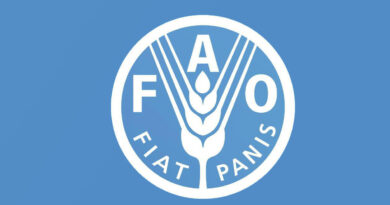Benchmark for world food commodity prices fall in March for the twelfth month in a row
10 April 2023, Rome: The benchmark index of international food commodity prices declined for the 12th consecutive month in March, driven by declines in world quotations for cereals and vegetable oils, the Food and Agriculture Organization of the United Nations (FAO) reported today.
The FAO Food Price Index, which tracks monthly changes in the international prices of commonly-traded food commodities, averaged 126.9 points in March 2023, down 2.1 percent from the previous month and 20.5 percent below its peak level of March 2022. A mix of ample supplies, subdued import demand and the extension of the Black Sea Grain Initiative contributed to the drop.
The FAO Cereal Price Index declined 5.6 percent from February, with international wheat prices falling by 7.1 percent, pushed down by strong output in Australia, improved crop conditions in the European Union, high supplies from the Russian Federation and ongoing exports from Ukraine from its Black Sea ports. World maize prices fell by 4.6 percent, due partly to expectations of a record harvest in Brazil, while those of rice eased by 3.2 percent amid ongoing or imminent harvests in major exporting countries, including India, Viet Nam and Thailand.
The FAO Vegetable Oil Price Index averaged 3.0 percent lower than the previous month and 47.7 percent below its March 2022 level, as ample world supplies and subdued global import demand pushed down soy, rapeseed and sunflower oil quotations. That more than offset higher palm oil prices, which rose due to lower output levels in Southeast Asia due to floodings and temporary export restrictions imposed by Indonesia.
“While prices dropped at the global level, they are still very high and continue to increase in domestic markets, posing additional challenges to food security. This is particularly so in net food importing developing countries, with the situation aggravated by the depreciation of their currencies against the USA dollar or the Euro and mounting debt burden,” stressed Máximo Torero, FAO Chief Economist.
The FAO Dairy Price Index declined 0.8 percent in March. Butter prices increased due to solid import demand, while those of cheese dipped due to slower purchases by most leading importers in Asia as well as increased availabilities in leading exporters.
By contrast, the FAO Sugar Price Index rose by 1.5 percent from February to its highest level since October 2016, reflecting concerns over declining production prospects in India, Thailand and China. The positive outlook for the sugarcane crops about to be harvested in Brazil limited the upward pressure on prices, as did the decline in international crude oil prices, which reduced demand for ethanol.
The FAO Meat Price Index rose slightly, by 0.5 percent. International bovine meat quotations rose, influenced by rising internal prices in the United States of America on expectations of lower supplies moving forward, while pig meat prices rose due to increased demand in Europe ahead of holidays. Despite avian influenza outbreaks in several large exporting countries, world poultry meat prices fell for the ninth consecutive month on subdued global import demand.
Also Read: Need to enhance customs duty to 30% on import of all Agrochemical formulations: CCFI
(For Latest Agriculture News & Updates, follow Krishak Jagat on Google News)















